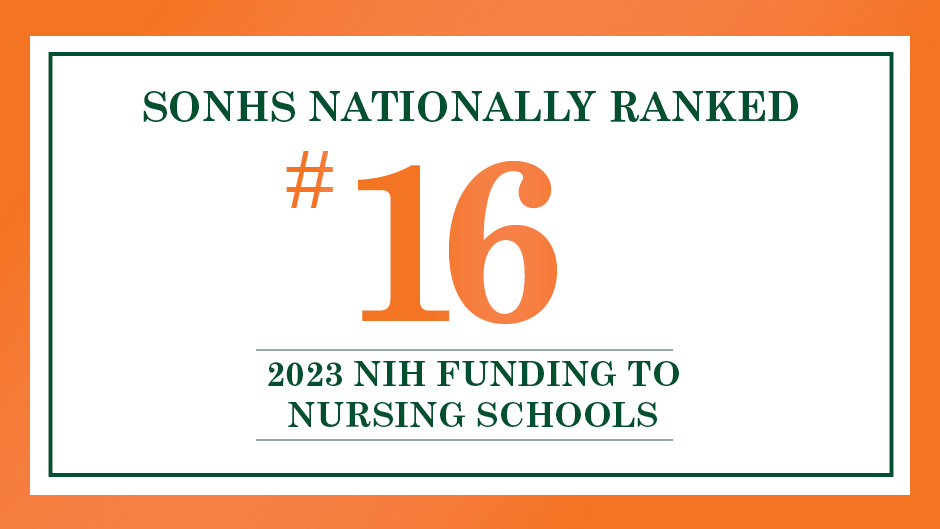The University of Miami School of Nursing and Health Studies (SONHS) has entered the top echelon of nursing schools nationwide. SONHS has attained the No. 16 position in the annual rankings of National Institutes of Health (NIH) research funding awarded to nursing schools across the United States, as confirmed by the latest data released by the Blue Ridge Institute for Medical Research.
Even more impressive, SONHS jumped nine spots in the rankings—from No. 25 in 2022 to No. 16 in 2023—and nearly doubled its year-over-year NIH research funding from $3,396,294 for fiscal year (FY) 2022 to $6,061,945 for FY 2023.
“This news further solidifies the School’s reputation for mission-driven health disparities research and our responsibility to advance the science in meaningful ways that will make marked improvements over time in the overall health and well-being of our communities,” said SONHS Dean and Professor Cindy L. Munro, PhD, RN, ANP-BC, FAAN, FAANP, FAAAS. “We are very proud to represent our state and the University of Miami in this way.”
SONHS first exceeded the $3 million mark for annual NIH funding in 2020, with steady increases through 2022. The significant jump in NIH funding and ranking in 2023 corresponds with the School’s overall focus on ending health disparities.
A significant portion of 2023’s funding increase can be attributed to the precedent-setting NIH grant SONHS was awarded to establish the Miami Environmental influences on Child Health Outcomes (Miami-ECHO) Program. “With the NIH ECHO Program support, we can help lead the ongoing discourse around maternal-child health disparities by focusing our research on South Florida, especially around Miami-Dade County," said lead principal investigator Hudson Santos, RN, PhD, FABMR, FAAN, SONHS Vice Dean for Research Affairs, Dolores J. Chambreau Endowed Chair, and interim Associate Dean for the University’s Graduate School.
"Our No. 16 ranking is phenomenal news and evidence of the great success that our team approach to the science of nursing and health studies has yielded,” said Dr. Santos. “As exciting as this stellar accomplishment is, we are just at the beginning of what we expect to achieve. We hope to transform health outcomes across diverse populations and create innovative interventions to eliminate health disparities and increase health equity."
The vibrant research ecosystem SONHS is building with impressive momentum reflects the unyielding dedication of its faculty, students, and staff, as well as their countless study participants, community collaborators, and clinical partners near and far, all of whom invest time, trust, and faith in the rigorous research process.
To learn more about the UM School of Nursing and Health Studies, visit sonhs.miami.edu.
###
About the University of Miami School of Nursing and Health Studies (SONHS)
Established in 1948 as South Florida’s first collegiate nursing program, SONHS is a world-class, prestigiously accredited, research-driven school conferring undergraduate and advanced nursing degrees, and undergraduate public health and health science degrees. SONHS values its diverse faculty, students, staff, and 250+ clinical and community health partners. Its research core includes the Jorie Healthcare Partners Biobehavioral Research Laboratory, PAHO/WHO Collaborating Centre, Center for Latino Health Research Opportunities, NIH-supported Minority Health and Health Disparities Research Training Program, and 41,000-square-foot Simulation Hospital Advancing Research and Education (S.H.A.R.E.®).
About the National Institutes of Health (NIH)
The NIH is the world’s largest public funding source for biomedical research for the American people, investing about $41 billion annually to enhance health, increase life spans, and reduce illness and disability. More than 80 percent of NIH’s funding is awarded for extramural research, largely through almost 50,000 competitive grants to more than 300,000 researchers at more than 2,500 universities, medical schools, and other research institutions in every state.

